Cuba is a country that speaks to the imagination. Every year millions of tourists flock to this Caribbean destination to enjoy its many beaches, to hike its diverse national parks or even just to get a taste of Havana city culture. Due to the communist political system, Cuba offers travellers a completely different feel compared to other Caribbean islands.
Among other things, the archipelago is renowned for its cigars and colourful classic cars. Read more about the Cuban culture, history and attractions.
Facts and figures
| Capital city | Havana |
|---|---|
| Official language | Spanish |
| Surface area | 109.884 km² |
| Population | 11.4 million (2021) |
| Religion | Catholic: 60%, Santería: 12%, Protestant: 5%, Non-religious: 23% |
| Currency | Cuban peso (CUP) |
| Time difference | 5 hours |
| Flight time | 10 to 12 hours |
| Plugs | Type A, B, C en L (adapter required) |
| Tap water | Unsafe to drink when untreated |
| Visa | Cuba visa required |
Map
The country of Cuba comprises several islands totalling a surface area of about 110,000 km² or 42,500 sq mi. The homonymous main island is the largest island in the Caribbean Sea and is located at about 100 miles or 160 km from the southern tip of Florida and about 190 km or 118 miles from Mexico. Cuba is surrounded by a number of other island countries, such as the Bahamas, Jamaica, Haiti and the Cayman Islands. With a population of over 2 million residents, the capital Havana is by far the biggest city on the island. Other major cities located on the main island are Santiago de Cuba and Camagüey. Apart from the main island, Cuba counts hundreds of smaller islands, of which Isla de la Juventud (Isle of Youth), located southwest of the main island, is the largest.
History
Precolonial history
Cuba’s first inhabitants, the Guanahatabey, were hunter-gatherers who populated the main islands from about 3500 BCE. Over the following millennia, the Taíno, an ethnic group originating from South-America, migrated north via the Lesser Antilles. When the Taíno finally arrived in what later would become Cuban territory, the Guanahatabey were pushed further and further to the west. Unlike the first inhabitants of Cuba, the Taíno were skilled farmers and grew cassava, corn and peppers. When the first of Columbus’ expeditions reached the shores of Cuba in 1492, the majority of the island was populated by the Taíno.
Columbus in Cuba
The Genoese Italian explorer Christopher Columbus started his journey over the Atlantic Ocean in 1492, by order of the royal couple of Spain. Although his mission was to find a sea route to Asia, he ended up encountering the Caribbean islands and Cuba. In the following years, many Spanish travelled to these places known as the ‘New World’. Colonial settlements were founded on different Caribbean islands, and in 1511 the Spanish started a war of conquest in Cuba. The Spanish fought against the Taíno, who were led by Hatuey, a resistance fighter from what is now Haiti that is still considered a national hero by a large part of the modern Cuban population. A bloody guerrilla-style war of three years followed. The European conquerors prevailed and Cuba was annexed to the Spanish colonial empire. In 1519 the colonial rulers founded the city of Havana, laying the foundations for modern Cuba.
The Spanish colony of Cuba
In the decades following the conquest of Cuba, the original population was systematically marginalised and exploited by the Spanish. The Taíno were forced to work and randomly murdered. Many thousands of Taíno also died due to illnesses brought by the Europeans. The Spanish did everything in their power to make Cuba into their primary base of power in the New World. Dozens of plantations were created for the cultivation of sugar and tobacco. Since there weren’t enough people left to work on these plantations, the Spanish transported several hundreds of thousands of slaves from the African continent to Cuba.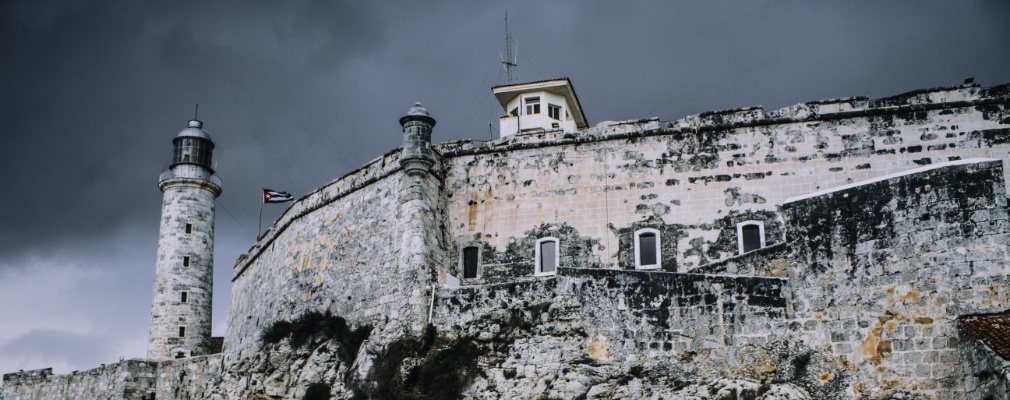 The ‘Castillo de la Real Fuerza’ was built in Havana under Spanish command in the 16th century and can still be visited today
The ‘Castillo de la Real Fuerza’ was built in Havana under Spanish command in the 16th century and can still be visited today
The Spanish were not the only ones interested in Cuba. Other colonial powers, including the English, the Dutch and the French, were also active in the Caribbeans. In 1628, the Spanish fleet was raided in Havana by a Dutch ship and the British undertook several attempts to gain control of Cuba during the 18th century, attaining a short-lived victory in 1762. These new rulers controlled the island of Cuba for shorter than a year, before trading it for Florida in 1763.
The road to independence
In the 19th century, there were multiple movements in Cuba that sought a form of independence from the Spanish crown. One of them was led by José Antonio Aponte, a carpenter of African origins who fought for the abolition of slavery. Other organisations formed, inspired by the independence fighter of South America. However, it wasn’t until 1868 that a major war between Cuban rebels and the Spanish broke out. After ten years of intense fighting, the Spanish army prevailed. In 1879, a second uprising against the Spanish was suppressed within a year. Only in 1886, several years after these events, slavery was finally abolished in Cuba.
Over the course of the following years, the political situation in Cuba remained unstable. Conflict between Spanish authority and the Cuban independence movement surged again in 1895. Soon, the Spanish sent an army of over 200,000 soldiers to Cuba to violently repress the insurrection. During this war, hundreds of thousands of Cuban civilians were deported to concentration camps, as the Spanish feared their collaboration with rebel forces. Over 170,000 Cubans died as a result of the harsh conditions in these camps.
Both within and outside Cuba, the rebels gained more and more sympathy. Images of the atrocities committed in Cuba spread over the world, causing the Americans to feel the urge to help the Cuban people. The US government in Washington, noticing that the conflict put American trade interests at risk, unleashed a short war against Spain. Spanish troops were defeated in 1898 and Cuba was occupied by American forces.
The Cuban revolution
US troops left Cuba in 1902 and the new country finally gained its independence. Still, the United States kept exercising a tremendous influence on Cuban politics and economy. Political leaders who were not in favour of the Americans were deposed and the Cuban economy became increasingly dependent on foreign investments. Toward the end of the 1950s, Cuba was governed with an iron fist by dictator Fulgencio Batista, who was supported by the Americans. The underground resistance against the government grew and in 1959 Batista was deposed by the Cuban revolutionaries led by Fidel Castro. Castro and his party then founded a single-party system communist state.
Communist Cuba
Castro’s regime reorganised Cuba’s government apparatus, introducing a centrally led planned economy and complete state ownership of all agricultural production. Many previously American-owned possessions on Cuba were confiscated and ties with the Soviet Union were tightened. This all led to the build-up of tensions between Cuba and the United States. Then, in 1961, Cuban exiles trained and financially backed by the Americans invaded a bay on the south coast of Cuba: the Bay of Pigs. This operation failed and the relations between the two countries soured even more. In 1962, tensions reached a high point during the Cuba crisis. The Soviet Union had placed nuclear missiles in Cuba, causing great indignation in the United States. The US army, in response, imposed a blockade encircling Cuba, whilst the Soviet Union’s fleet was on its way to support the Cubans. Fortunately, the conflict did not escalate.
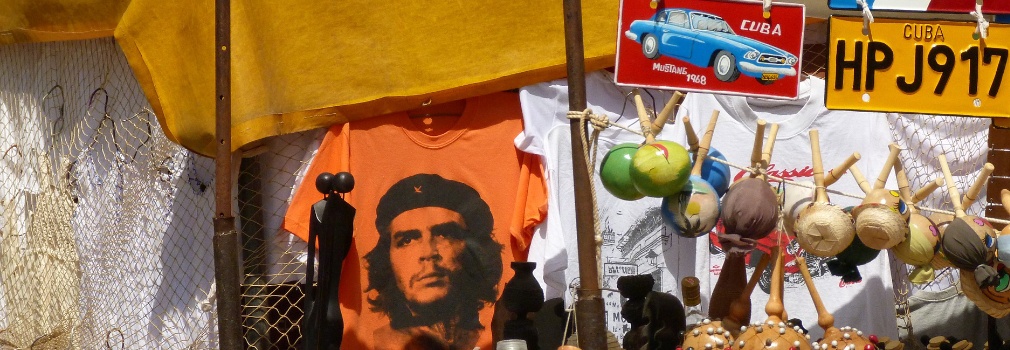 Cuban streets are often decorated with effigies of the communist revolution
Cuban streets are often decorated with effigies of the communist revolution
During the second half of the 20th century, Cuba was frequently plagued by economic instability. Western countries had imposed trade embargoes that made it difficult for Cuba to obtain certain resources. In addition, Cuban militias were involved in many international conflicts, leading many countries to consider Cuba as a sponsor of terrorism. Over the decades, the strict communist policies were loosened, offering greater opportunities to private businesses. Simultaneously, more and more tourists visited Cuba, generating money and helping the local economy.
Culture
Iberian Spanish culture has heavily influenced Cuban society over the course of modern history. The vast majority of Cubans adhere to the Catholic Church, Cuban architecture is heavily inspired by historic Spanish architecture and Spanish is the official language of the country. As a result of the transatlantic slave trade, influences from different African peoples can also be found in modern Cuba. Many Cuban dances and music genres originate from Africa, with Cuban dances such as salsa and rumba being known all over the world. Hardly any traditions remain of the Taíno, the original inhabitants of Cuba, as many of them did not survive the European diseases and the wars against the Spanish. Today, there is still a small group of Cubans who claim to descend from the Taíno.
Driving in Cuba
Anyone who travels to Cuba immediately notices that the streets are still filled with cars from the 1950s. Due to the trade embargo imposed by the United States, no modern cars could be exported to the island nation. Therefore, Cubans had to make do with whatever was already on the island. The classic cars that still circulate in Cuba have been repaired multiple times over the years and often seem to be on the verge of falling apart.
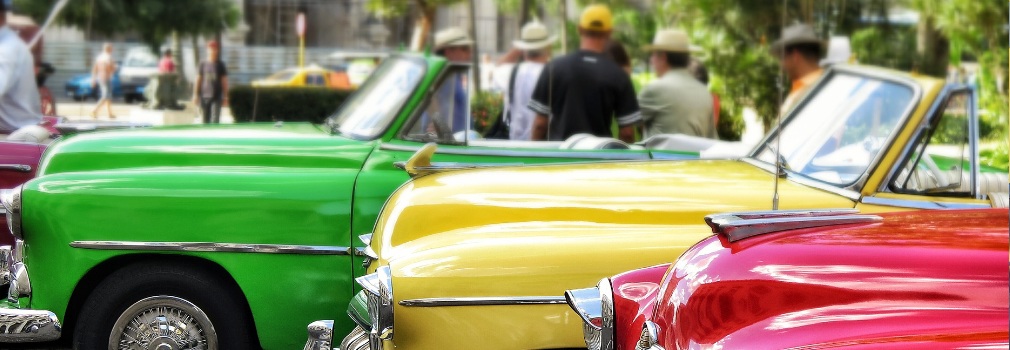 Cuba is famous for its many classic cars
Cuba is famous for its many classic cars
Climate
The vast majority of Cuba has a tropical savannah climate. In the northwest and the east of the main island, however, the country has a tropical rainforest climate. Certain coastal areas have a monsoon climate. The rainy season starts in May and lasts until November. The period between November and April is usually dryer. Still, precipitation patterns are characterised by a considerable regional variation.
Due to its tropical climate, Cuba knows a large variety of flora and wildlife species. Unfortunately, due to the creation of sugarcane, coffee and rice plantations over the past centuries, much of the natural environment has been lost. Nowadays, about one-fourth of the Cuban surface area is covered by rain forests and other woodlands.
The average temperature in Cuba lies around 23 degrees in January and 27 degrees in July. Therefore, the climate makes Cuba a year-round attractive travel destination. Due to the lower temperatures and limited rainfall, and to avoid the relatively crowded summer months of July and August, many travellers choose to travel to Cuba between the months of November and April. Fewer tourists travel to Cuba in May, June, September and October, making these months ideal for those who are looking for a quieter holiday.
| Month | Average maximum temperature in °Cø max. temp. in °C | Average minimum temperature in °Cø min. temp. in °C | Average number of days with rainfallø days with rainfall |
|---|---|---|---|
| January | 29 | 18 | 3 |
| February | 30 | 19 | 4 |
| March | 31 | 20 | 6 |
| April | 31 | 21 | 6 |
| May | 32 | 22 | 9 |
| June | 33 | 23 | 9 |
| July | 34 | 24 | 8 |
| August | 34 | 24 | 8 |
| September | 33 | 24 | 7 |
| October | 32 | 23 | 6 |
| November | 32 | 22 | 5 |
| December | 30 | 20 | 3 |
Tourism
There are many activities for travellers to enjoy in Cuba. The island is not only great for a beach holiday, but also for exploring Cuban cities and tropical nature. Keep reading to find out more about the versatility of the island.
Beach holiday in Cuba
With over 3,500 miles of coastline, Cuba is the perfect destination for a beach holiday. The seawater has a pleasant temperature ranging between 24 and 29 degrees throughout the year, which makes it perfect for the more enthusiastic swimmers. The island has many beautiful beaches and also offers several attractive spots for snorkelling. It is also possible to take boat trips across the turquoise waters that surround Cuba.
Cuba’s most popular cities
With more than 2 million inhabitants, Havana is both the capital and the largest city in Cuba. It is also the most visited city. The oldest neighbourhood, Habana Vieja, or Old Havana, is very popular among tourists. This part of the city is almost entirely walkable and has many small shops and museums. Another interesting neighbourhood is Vedado, in the north of Havana. This part of the city is inhabited by rich Cubans and is not very heavily visited by tourists. Central Havana, another neighbourhood that lies between Habana Vieja and Vedado is mainly popular among tourists who want to experience the city's hectic life and is in fact the most densely populated part of the city.
Located just under 200 miles east of Havana, Trinidad is the second most popular destination for tourists after the capital. The city lies between the mountains and the sea, giving tourists a wide range of things to do. For instance, there are plenty of opportunities for hiking and enjoying the warm waters of the Caribbean Sea. Trinidad is also known for its many buildings dating back to the colonial era.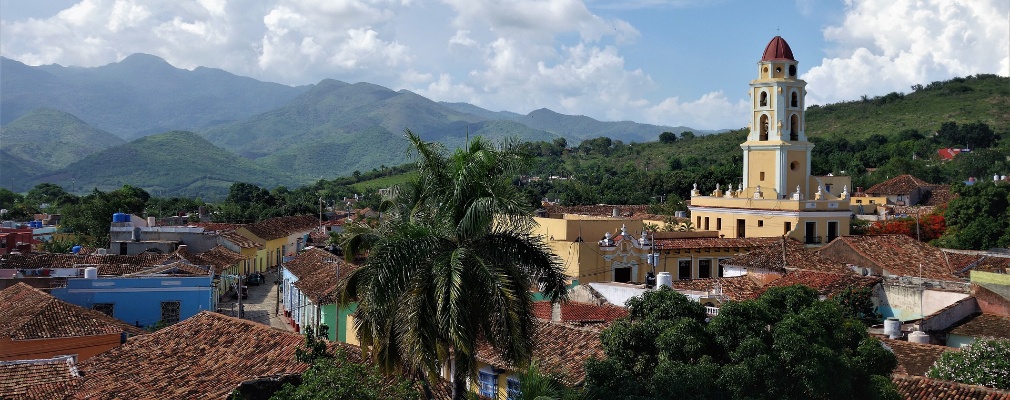 Trinidad is the second most popular city among tourists after Havana
Trinidad is the second most popular city among tourists after Havana
The city of Cienfuegos, located on the southern coast of Cuba, was founded by the French. This is still visible in the many French street names. The city is known as the pearl of the south. Its many old buildings and beautiful coastline are undoubtedly worth a visit.
Cuban nature
Besides its vibrant city life, Cuba also has a lot to offer in terms of natural beauty. The island counts 14 national parks, each with its own unique nature. Hikers like to venture inland to enjoy the Caribbean natural landscape.
The Viñales Valley is on the wish list of many backpackers. This valley in the far west of Cuba is known for its so-called Mogotes, limestone rocks that have rounded tops due to erosion. The area also offers several bike trails.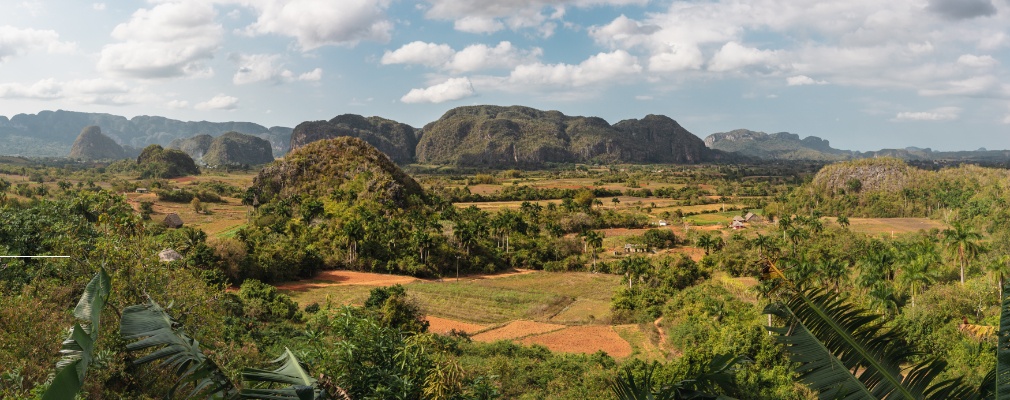 Cuba’s Viñales Valley stands out for its signature limestone rocks
Cuba’s Viñales Valley stands out for its signature limestone rocks
Hiking enthusiasts also enjoy visiting Topes de Collantes nature park south of Trinidad. Here you can make a spectacular hike to Leaping Caburní (Salto del Caburní), a 62-meter-high waterfall. Don’t forget to take a dip into the waterfall lake while you’re at it.
Another well-known natural landscape can be found in Cuba’s far east, a few miles west of the city of Baracoa. Here you can hike up to the mountain tops of El Yunque. Although it may prove difficult to walk up the hiking paths due to dense foliage, its spectacular mountain views will definitely make it worth the visit.
Economy and currency
Cuba is governed according to strict socialist principles. This means the state has direct control of many economic sectors. The government sets sales prices for many everyday items, and starting businesses for profit was strictly prohibited for a long time. Over the last decades the rules have been loosened, making it possible for Cubans to open small businesses. The central government, however, retains full authority over economic policies.
In Cuba, payments are made using the Cuban peso (CUP). Banknotes are issued in denominations of 1, 3, 5, 10, 20, 50, 100, 200, 500 and 1000 pesos. There are also 1, 3 and 5-peso coins as well as 5 and 20-cent coins. Cubans themselves tend to pay with cash, so please make sure to carry sufficient cash money with you when travelling. ATMs can be found in Cuba’s main cities, but you can only take out money here using a credit card. Please note that credit cards issued by US banks are often not accepted. 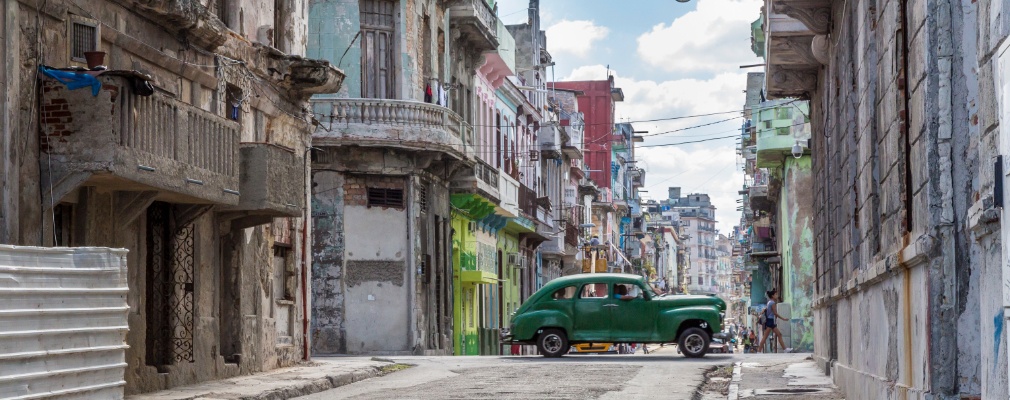 Havana’s city centre
Havana’s city centre
Tipping for small services is very common in Cuba. However, bear in mind that money can sometimes be asked for unsolicited advice, especially around tourist attractions.
Safety
Compared to many other Latin-American countries, Cuba is fairly safe. However, crime exists. Avoid dimly lit streets and watch out for pickpockets.
Tropical storms regularly occur in Cuba between June and November. Keep an eye on the local weather forecast and always keep the right emergency number at hand.
Mosquitoes in Cuba can carry diseases. Make sure you bring sufficient anti-mosquito repellents with you to protect yourself from mosquito bites.
Visa
To travel to Cuba you need a visa. You can apply for it using an online form for € 44,95 per visa. You will receive your visa by e-mail. Remember that you need to activate your visa manually via the D'Viajeros form. If you travel to Cuba from the United States, you will have to apply for another, more expensive visa variant.
Apply for the Cuba visa now
e-Visa.ie is a commercial and professional visa agency, and supports travellers in obtaining, among others, the Cuba visa. e-Visa.ie is an official partner of the International Air Transport Association, IATA, with membership number 57231226, acts as an intermediary, is no law firm, nor does it employ lawyers, does not provide legal advice, and is in no way part of any government. You can also apply for a visa directly with the immigration service (20 EUR per visa). However, not with our level of support. If you submit your application via e-Visa.ie, our support centre is available to you 24/7. We also check your application before submitting it to the immigration authorities on your behalf. If we suspect any errors or omissions while doing so, we will personally contact you to ensure that your application can still be processed quickly and correctly. To use our services, you pay us 20 EUR in consular fees, which we pay to the immigration service on your behalf, as well as € 24,95 in service fees as compensation for our services, including VAT. Our services have saved many travellers from major problems during their trip. Should an application be rejected despite our support and verification, we will refund the full purchase price (unless an application for a previous Cuba visa was rejected for the same traveller). Read more about our services here.